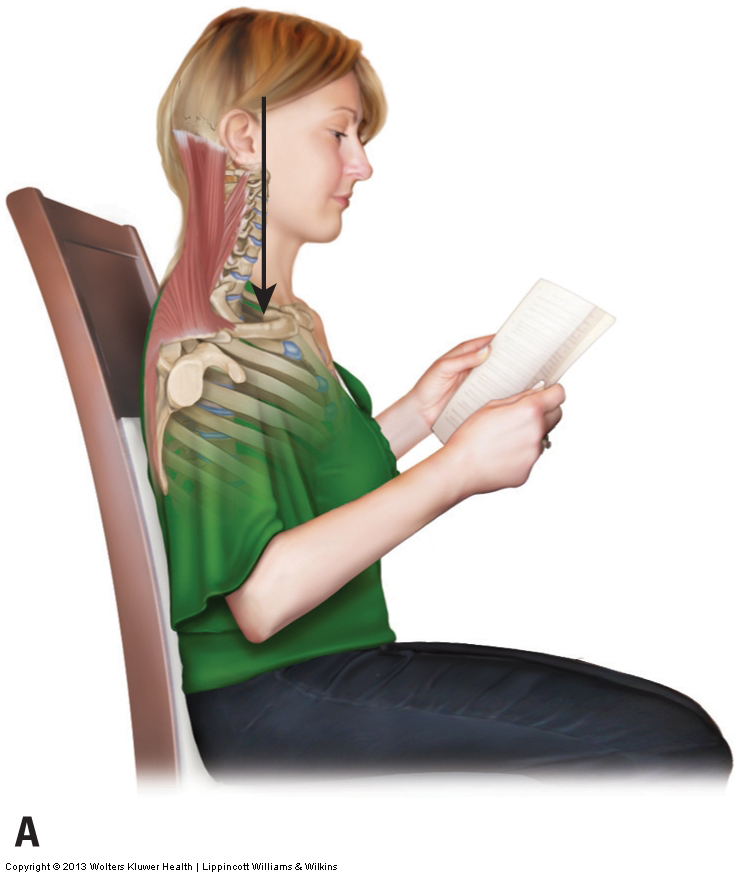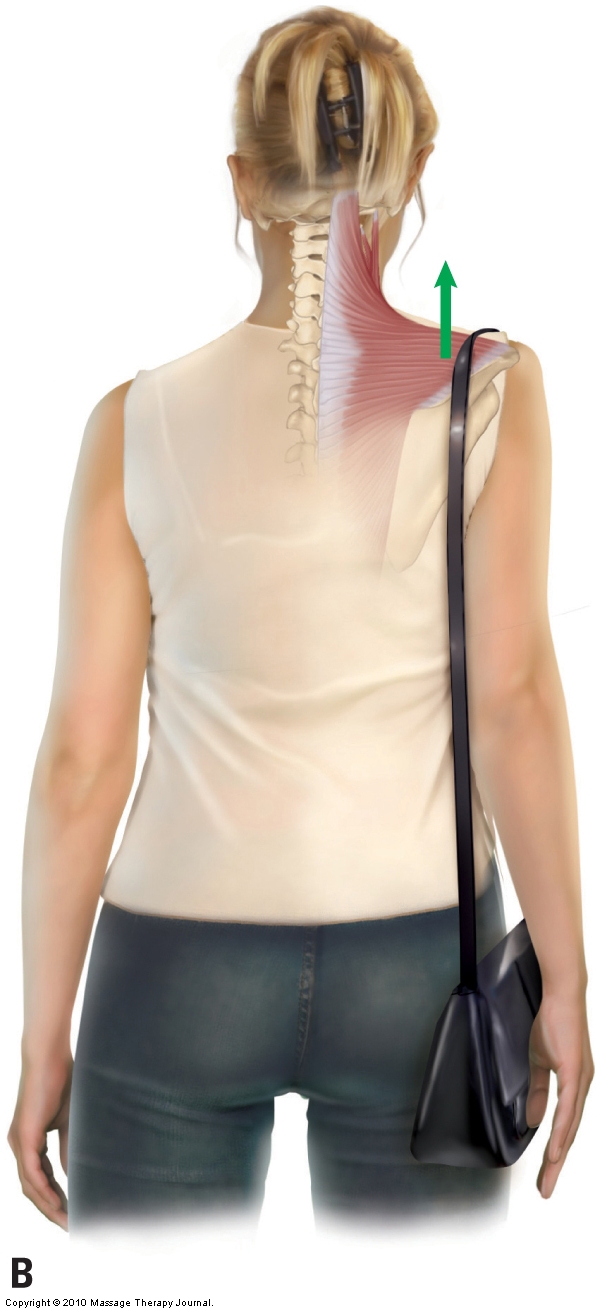Note: This is the fourth blog post article in a series of 14 articles on Assessment/Diagnosis of musculoskeletal conditions of the neck (cervical spine). See below for the other articles in this series.
Postural assessment is usually the first physical assessment procedure that is performed. The term posture means position; therefore, in postural assessment, the client’s static position is evaluated. Before evaluating a client’s posture, it is important to understand what is meant by good posture and poor posture.
- Good posture is defined as a balanced posture that is symmetrical and does not place excessive stress on the tissues of the body (Fig. 1A).
- Bad posture, in contrast, is asymmetrical and/or imbalanced, and places excessive physical stress on the tissues of the body (Fig. 1B).
- When evaluating a client’s posture, look for asymmetries and deviations, as these will indicate increased stress forces on the tissues of the body.
- When a client has a postural deviation, it is important to determine why it is occurring and what tissues are stressed as a result of the posture.


Figure 1. Good and bad neck posture. (A) The client’s posture is considered good because it is symmetrical and the weight of the head is balanced over the trunk. (B) The posture could be called bad because the head is not balanced over the trunk, and this places extra stress on the muscles to maintain the posture. For example, the extensor muscles must contract isometrically to prevent gravity from pulling the head and neck down into flexion. Courtesy Joseph E. Muscolino.
Which postures to evaluate?
- There are an infinite number of postures/positions that a client may assume during the day.
- Unfortunately, therapists usually perform only standing postural assessment, often using a plumb line. (A plumb line is a string that has a weight attached to it [“plumb” comes from the Latin word for lead] so that the string hangs perfectly vertical, allowing the therapist to check for symmetry relative to the vertical line.)
- Although standing posture may be important to evaluate, it is not the only posture that should be assessed. In fact, depending on the client’s profession, hobbies, and activities, it may not even be pertinent to the client’s condition.
- It is important to assess all postures that the client assumes. For clients with neck problems, sitting posture is especially important, such as when sitting at a desk to do paperwork or work on a computer.
- Therefore, in addition to performing the usual standing plumb-line postural assessment, if a desk or perhaps even a computer is nearby, it can be helpful to ask the client to sit down and demonstrate his or her seated working posture.
- Given that most people spend 6 to 8 hours a day sleeping, it is also important to find out what position or posture the client usually sleeps in (this is usually done during the health history).
A few examples will illustrate the critical reasoning skills involved in a client’s postural assessment in which a postural deviation was found.
 Figure 2. Carrying a bag or purse on a shoulder will cause a postural asymmetry with one shoulder girdle held higher than the other. Courtesy Joseph E. Muscolino. Art work by Giovanni Rimasti. Originally published in the massage therapy journal (mtj), spring 2010 issue: seven keys to healthy neck posture.
Figure 2. Carrying a bag or purse on a shoulder will cause a postural asymmetry with one shoulder girdle held higher than the other. Courtesy Joseph E. Muscolino. Art work by Giovanni Rimasti. Originally published in the massage therapy journal (mtj), spring 2010 issue: seven keys to healthy neck posture.
- Example 1: A common postural deviation occurs when one shoulder is higher than the other, as from carrying a purse or a bag on the higher shoulder (Fig. 2) or crimping a phone between the ear and shoulder. This often indicates overuse of the muscles in that region, such as the upper trapezius and levator scapulae, so the therapist would know to specifically evaluate these muscles during the palpation and ROM assessments. If these muscles are tight, treatment might also target these muscles and might include home advice for the client regarding stretching and/or hydrotherapy. Other recommendations to help alleviate the condition might include avoiding certain postures or modifying postures and activities that cause or perpetuate this condition.
- Example 2: If the client’s posture shows that the head and neck are held asymmetrically in right lateral flexion, it would be reasonable to suspect that the right lateral flexor muscles are tight. The therapist would then focus on assessing these muscles; if they are revealed to be tight, the therapist would direct treatment and home advice toward their care.
Given the focus and scope of this series of blog post articles, only postural deviations of the neck have been mentioned. However, postural deviations often involve the entire body, with a problem in one area causing secondary consequences and compensations in other regions. For example, a dropped arch in the foot may lead to an iliac crest height that is low on one side with a compensatory scoliosis that may reach to the cervical spine. For this reason, postural assessment should always address the client’s entire body, from the feet to the head. After the therapist has taken a look at a full body assessment of the client’s posture, then appropriate treatment can be performed.
(Click here for a blog post article on postural assessment of the low back and pelvis.)
This blog post article is the fourth in a series of 14 blog post articles on Assessment/Diagnosis of musculoskeletal (neuro-myo-fascio-skeletal) conditions of the neck (cervical spine).
The articles in this series are:
- Introduction to Assessment/Diagnosis of the Neck
- Verbal and Written Health History
- Overview of Physical Examination Assessment
- Postural Assessment
- Neck General Orthopedic Assessment: Range of Motion and Manual Resistance
- Palpation Assessment
- Motion Palpation (Joint Play) Assessment
- Special Orthopedic Assessment Tests for the Neck – Space Occupying Conditions
- Special Orthopedic Assessment Tests – Space Occupying Conditions – Slump Test
- Orthopedic Assessment of Thoracic Outlet Syndrome – Adson’s, Eden’s, Wright’s
- Orthopedic Assessment of Thoracic Outlet Syndrome – Brachial Plexus Tension Test
- Special Orthopedic Assessment Tests – Vertebral Artery Competency Test
- Treatment Strategy and Treatment Techniques
- Assessment and Treatment of Specific Musculoskeletal Conditions


